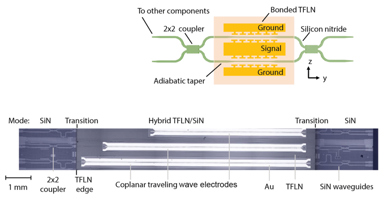 [Enlarge image]Schematic (top) and photograph (bottom) of hybrid-mode Mach-Zehnder modulator (push-pull configuration).
[Enlarge image]Schematic (top) and photograph (bottom) of hybrid-mode Mach-Zehnder modulator (push-pull configuration).
Heterogeneous integration of thin-film electro-optic (EO) crystals is a powerful tool for incorporating high-performance EO microsystems, building on existing silicon photonics technology without having to start from scratch. Among the desirable attributes of EO modulators are high bandwidth and low voltage. Silicon photonic modulators do not support high-contrast, low-chirp modulation with greater than about 60 GHz bandwidth. Low-voltage silicon microresonator modulators cannot handle optical powers greater than a few milliwatts without nonlinear impairments. High-performance modulators on silicon nitride and other short-wavelength photonic platforms have not yet been demonstrated.
In recent work, we have designed and built EO modulators based on hybrid modes—in which the light is distributed in more than one core material—using thin-film lithium niobate (TFLN) with silicon or silicon nitride waveguides. The width of the waveguide is varied to controllably push and pull light from the unetched TFLN region. Outside the bonded region, compact bends, couplers and other devices can be implemented using silicon or silicon nitride components already in many process design kit (PDK) libraries.
To demonstrate the concept, foundry processing at Sandia National Labs, USA, was used for making the Si/SiN features, following which we incorporated TFLN over the desired regions using a low-temperature direct-bonding process and formed the traveling-wave electrodes.1,2 We produced integrated Mach-Zehnder modulators that operate at 1.3 µm and 1.55 µm, which are traditional fiber communications wavelengths, and at 780 nm. In each band, we demonstrated 3-dB modulation bandwidths exceeding 100 GHz. We also achieved half-wave voltages Vπ of about 2 to 3 V at 1.3 µm and 1.55 µm, and 1 V at 780 nm.3,4 At 1550 nm, we showed that optical powers above 100 mW can be modulated at these high radio frequencies.5
Compared with traditional silicon photonic modulators, the larger bandwidth and reduced voltage of hybrid modulators can support higher data rates, increase efficiency and improve analog links. At shorter wavelengths (where silicon modulators cannot be used), these high-performance integrated modulators can generate high-bandwidth waveforms and bridge the gap between free-space and fiber communications.
Researchers
Viphretuo Mere, Forrest Valdez, Xiaoxi Wang and Shayan Mookherjea, University of California San Diego, La Jolla, CA, USA
References
1. V. Mere et al. J. Phys. Photon. 4, 024001 (2022).
2. V. Mere et al. J. Opt. Soc. Am. B 40, D5 (2023).
3. F. Valdez et al. Opt. Express 31, 5273 (2023).
4. F. Valdez et al. Optica 10, 578 (2023).
5. F. Valdez et al. Sci. Rep. 12, 18611 (2022).
